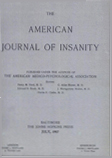Abstract
The three cases represent, we believe, attempts to compensate for emotional repression, which has been associated with a distressing mental conflict.
In the first case, there was an internal fermentation, which bubbled over in an antisocial way when the patient, because of unusual strain in her environment that made her past more oppressive than usual, was unable to obtain an emotional outlet and a feeling of compensation through her religion. Had it not been for her mental conflict during sixteen years, she would not, we believe, have become delinquent in the eyes of the law. There seems little probability now of her delinquency being repeated. That she chose the outlet she did instead of others apparently resulted from the fact that this particular act typified to her the worst thing she could do and represented an attempt to win back favor and effect a reconciliation. The sex avenues were blocked on account of her fear and sense of shame. No associations could be ascertained in our brief study to explain why the stealing of a hand-bag was to her such a terrible thing. Some more definite relationship, however, may be revealed later on. The interesting characteristic of this case was her ready accessibility and her quick response to treatment. Those who have worked and struggled with delinquents of the institutional type will appreciate finding a patient with whom so much could be accomplished in two interviews.
In the second case, the actual conflict centered about her married life, that is, her difficulty in adjusting herself to marital conditions and her inability to obtain children by adoption. The reason for suddenly making the decision that launched her into the predicament of her marriage was a conflict with the authority of her father, which resulted largely from the unwise training that had allowed her almost supreme mastery during her childhood and from her excessive dependency on him. When at the age of eighteen, she suddenly felt her father forcibly exercising his authority, the situation was intolerable to her and she took the quickest way out, regardless of consequences. Her inability to become eventually reconciled to her husband resulted partly from her dream world habits, which had prevented her from making satisfactory contacts with reality, and partly from rebuffs that her emotions had had at various times in her development that prevented them from seeking expression in an adult way and that repressed them to a lower level in a filial relationship with her father which had become wholly satisfying to her up to the time of his business reverses and with which she had made up her mind to content herself throughout her whole life.
In the third case, as in the first, emotions had been aroused at an early age in a way in which there was such a strong association of shame that everything even remotely connected with the sexual sphere had in consequence been repressed. The energy that had been repressed as a result of the conflict had expressed itself asocially in several ways, one of which was stealing. The outlets that she chose seemed to furnish her in some way with what we have called an illusion of compensation. Whether or not the early stealing from the mother was a factor in directing the energy that was seeking vicarious outlet, it was not possible to determine in the limited time remaining after the conscious emotional levels were reached. The future analysis of the case should be full of interest.
In all three cases, had the mental life been accessible to wise guidance at an earlier period, the antisocial behavior might easily have been prevented. While the court clinic and the institution laboratory can do much to reconstruct the re-educable delinquent, the real opportunity for constructive work is in the community where a knowledge of the principles of mental hygiene can be spread abroad through the education of the public en masse and through individual contact so that, among other things, mental conflicts and social maladjustments may be recognized and treated before they cause antisocial conduct and mental abnormalities.

